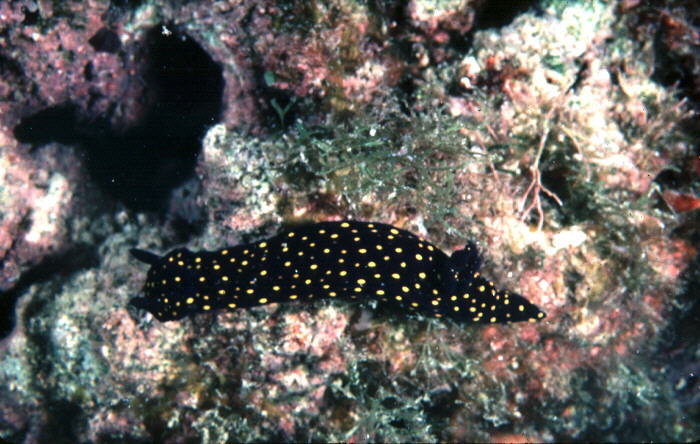 |
Hypselodoris ghiselini
Photographed at Puerto Chileno, Baja , Baja California, Mexico, 15 feet deep, 1984
Hypselodoris ghiselini Bertsch, 1978
Deep, dark indigo blue with brilliant yellow dots. The rhinophores and gills are also the same navy blue. The gills have small yellow dots on their inner surface. The animal produces an obnoxious metabolite called ghiselinin. Most likely it is a chemical for defense against predators. I named this species for my major professor at University of California, Berkeley, Dr. Michael T. Ghiselin. He seemed to be more honored with the eponymic obnoxious chemical!
Its coloration is interesting because it is not unique. A number of sympatric species in the Gulf of California share the same pattern: Hypselodoris agassizii, Polycera alabe, Navanax inermis, and a polyclad flatworm. Since they do not all occur in the same habitat, a study of this color pattern in situ would definitely be intriguing.
Although this species occurs throughout the Gulf of California (from Puerto Peñasco to La Paz), I have found it to be more common in year round, warmer, more southerly waters. In a 3-year study (January 1992-1995) at the subtidal reef at Punta la Gringa (Bahía de los Ángeles, Baja California), I only found 12 specimens. This can be contrasted with 1275 Tridachia diomedea 521 Doriopsilla gemela, and 80 Phidiana lascrucensis found during the same time span. During a one month time span (June 1985) diving in the Las Arenas area (east of La Paz), I recorded 61 H. ghiselini. On another personal note, hot water New Guinea diver Mary Jane Adams accompanied me here in June 1985 for a week, during which time we saw 12 H. ghiselini. The attached in situ picture of a copulating pair I photographed at Puerto Chileno (north of Mulege, B.C.S.).
Hypselodoris ghiselini resembles the near allopatric Hypselodoris californiensis This latter species has a lighter blue coloration and a light blue margin around its notum. Jim Lance’s excellent photograph shows this difference quite well.
This species was one of the first nudibranch species named using scanning
electron microscopy to illustrate the radula. The attached pictures are my
never before published SEMs of the rhinophore of H. ghiselini. Scan 1 , Scan 2 , and
Scan 3 .
Dr. Hans Bertsch
Imperial Beach, Calif
June 2001
Photos and Taxonomy text courtesy of Dr. Hans Bertsch
Underwater photo of Hans at Bahía de los Angeles

|
Assoc. Prof. |
AS A REMINDER
WESTERN SOCIETY OF MALACOLOGISTS
34th Annual Meeting, 20-24 June 2001
Sunny San Diego, California
This year's meeting will be held in San Diego at the Ramada Inn and
Conference Center. Call for Papers and Registration Forms are available
through the President, Dr. Hans Bertsch:
192 Imperial Beach Blvd. #A
Imperial Beach, CA 91932
or phone him: 619 423-8900 or email: hbertsch@nu.edu
This very exciting meeting will feature an outdoor barbecue followed by a special shell and book auction to benefit the society's Student Grant Fund. Thursday will be especially significant, with an Opisthobranch Symposium. It will be a Festschrift in honor of the 50th Anniversary of the death of Frank Mace MacFarland. Dr. Angel Valdes (avaldes@CalAcademy.org) is in charge of organizing this; please contact him and Hans for more information. So far presenters include Rebecca Johnson, Angel, Terry Gosliner, Mike Miller, Mary Jane Adams, Alan Grant, Hans, Jim Lance, Clay Carlson, and others. We certainly welcome additional people to present 20 minute talks or slide shows!! If you wish to simply attend, that is also encouraged.
Friday a Latin American Symposium is scheduled. Organized by Dr. Jorge Caceres (CICESE, Ensenada), it looks to be quite exciting. Please contact him (jcaceres@cicese.mx) or Hans for contributions to this symposium.
Saturday we will have contributed papers (including a sequence of papers by Cynthia Trowbridge on sacoglossans), and the evening banquet. This year our banquet speaker is Dr. Paul Dayton of Scripps Institution of Oceanography. A must event!
On Sunday, 24 June, Miguel Tellez will lead a geological field trip to the Ensenada, Baja California area. This will end with a special dinner at Haliotis, one of Ensenada's finest--but reasonably priced--restaurants.
And wait until you see the t-shirts and coffee mugs available for purchase!
So, if you haven't already sent in your registration forms and fees,
there is still time. It will be a great event, and you are all welcome to
attend.
Many thanks,
President, Western Society of Malacologists, 2001
Send Hans email at hbertsch@nu.edu
